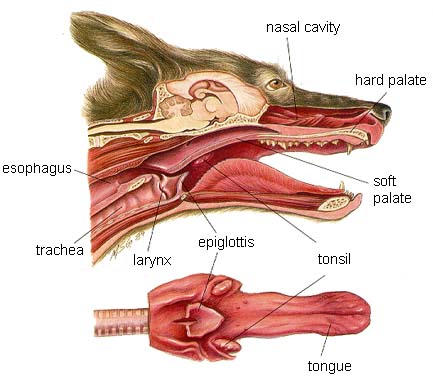Dog Cold Symptom: Causes Based on Color of Nasal Discharge
Symptoms of dog sneezing and nasal discharge indicate some type of medical problem in the nasal cavity. As indicated on the previous page, symptoms can indicate a wide range of problems including infections, foreign objects, injury or tumors (neoplasia).
Clinical signs or symptoms, such as the symptom itself (sneezing, discharge, reverse sneezing or harsh or whistling sounds) can provide some indication as to the cause (see first table below). The color of the nasal discharge color (see bottom table below) can also provide clues as to the cause.
Anatomy and Dog Upper Respiratory Problems
A veterinarian will start an examination by using the clinical signs to locate the part of the respiratory tract that is causing the problem. The table below matches typical dog cold symptoms to the dog's anatomy.
Dog Cold Symptom and Area of Nasal Anatomy
|
| Symptom |
Location of Dog Nasal Problem |
Dog sneezing or that has nasal discharge
|
- Nose
- Nasal Cavity
- Nasal Sinus
|
Reverse dog sneezing, loud dog snoring when sleeping (refereed to as
stertor)
|
- Narrowed breathing passages
- Problem with the passage that connects the nasal cavity to
the top of the throat (nasopharynx)
|
Whistling or harsh sounds when the dog is breathing (stridor)
|
- Problem in the larynx (he air passage between the lower
pharynx and the trachea)
|
Dog Nose Anatomy
Source: The picture of dog nasal anatomy shown above is reprinted with permission by the copyright owner, Hill's Pet Nutrition, from the Atlas of Veterinary Clinical Anatomy. These illustrations should not be downloaded, printed or copied except for personal, non-commercial use.
This is a complicated area of a dog's body, making it difficult to quickly identify the problem based on symptoms alone.
Nasal Discharge Color and Related Causes For Dog Congestion
Dog Cold Symptom - Nasal Discharge Color
|
| Dog Nasal Discharge Color |
Possible Cause when accompanied
by dog sneezing |
Clear (serous)
|
- Canine
Allergies: sneezing is usually intermittent. Other
symptoms including itching, scratching, dog hair loss, licking of the
paws, and face rubbing. Treated by identifying and removing the cause.
- Dog Nasal Mites:
The mites cause clear discharge from both
nostrils. Treated with prescription medications.
|
Cloudy, Gray or Green: may contain pus or mucus (gel like)
|
- Foreign object in
the nose (such as weeds or grass): results in pawing at the nose
and sneezing which becomes more intermittent over time. Discharge tends
to be from one nostril.
- Infection in the roots of
the upper teeth causing an abscess: discharge is usually from
one nostril. As disease worsens discharge can spread to both nostrils.
- Dog nose cancer
(nasal cancer) - blood may be present in the discharge (note that if dog sneezing is violent, this
can cause some blood to appear without the presence of cancer or
infection). Dog nasal tumors are difficult to surgically
eliminate. If left untreated, tumor growth can result in seizures or
changes in canine behavior.
- Fungal infection:
blood
may be present in the nasal discharge. Caused by Aspergillus. Treated
with fungal medications.
|
References for Dog Worms Types
IVIS – International Veterinary Information Service
Atkins, Clarke E. DVM, Canine Heartworm Disease: Prevention and Treatment
Heartworm Disease in Dogs; Venco, Luigi
U.S. Food and Drug Administration
Researched by: Jeff Grill

